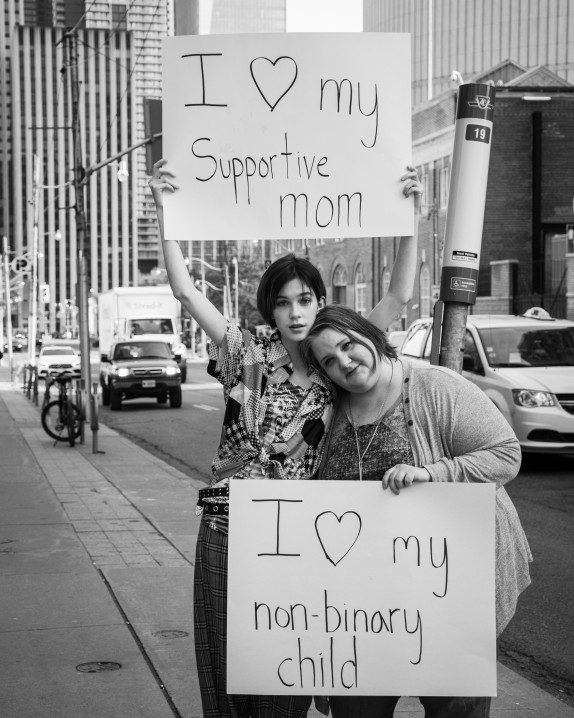Annastacia / Canada
“In a family of mostly boy children, our family was over the moon to have a girl. They made much-a-do. There were ‘plans.’ Looking back on it now, the attitude feels strange and uncomfortable. Such fixation on biology. Such excitement and expectation for an inanely meagre social construct. It turns out neither of my children follows this path.
Vaughan self-identified trans-masculine in 2015 going into their 5th grade. For a few reasons, they were struggling at their previous school, experiencing consistent harassment from classmates as their social dynamic became nuanced and challenging to maneuver. It’s common among feminine-presenting neurodivergent tweens, especially when the diagnosis comes later. One of the ways to address it was to switch up Vaughan’s school environment for a reset. The gender self-identification came seemingly out of nowhere. However, in hindsight, there were visible signs we didn’t pick up on—the ‘spumoni in the pudding,’ as it were. Vaughan chose to come out to us during the intake meeting with their new school in the presence of the new principal.
Vaughan is a student within the public Hamilton-Wentworth District School Board. The school board policy regarding sexual and gender diversity is a decent one. It is child-directed. The mandate is to create a safe space for students and allow them to direct how much or how little to disclose to the student’s parents because outing a minor from an unsupportive home can endanger the student and/or destroy their mental health.
The new school had a safe-space rainbow triangle posted in the front hallway, so Vaughan chose to trust they could relax and disclose at that moment. I think it’s worth noting that their new school had this poster visible for display, while their old school did not. So, despite policies in place, a school’s character greatly mirrors the principal’s leadership. Queer students still often struggle with zero tolerance policies that eschew context and see Queer students disciplined along with their harasser when conflict arises regardless of discriminatory speech or action aimed at them unprovoked. Such a case recently prompted a student walkout in Vaughan’s high school, so by demonstration, there is still work to be done.
The principal at the new elementary school was proactive and immediately talked directly with Vaughan and asked how they should address them. Bill and I followed Vaughan’s lead, and the following two years, it was a complete social transition with clothing, he/him pronouns, etc. With Vaughan’s permission, the school amended pronouns for all communication. If Vaughan had changed their name, the board policy would have also directed the use of their preferred name in the classroom. Vaughan was invited to use whichever bathroom they felt most comfortable in and was also given the option of a single-use bathroom, which they preferred.
It was about 2017; in their 7th year, Vaughan finally had discovered language and descriptors for non-binary. A quick switch prompted by an ‘Ah ha!’ moment. I’ll admit, the transition to they/them pronouns was more challenging to master. Even with their transition from she to he, it’s still a binary. As a society, we are inordinately fixated on this binary and conditioned so fervently that we do it unthinkingly.
My parental ‘hurdle’ to overcome was the feelings and internal biases regarding the perception of the process indicative of gender discovery. I completely acknowledge this was my issue to work through and tried very hard never to let Vaughan know how I felt. I concealed it.
The issue? Here it is; I had this uncomfortable presumption of social pressure that my child be more decisive with their gender identity. For the most part, the outside response from friends and family surrounding Vaughan’s trans-masculine shift was more supportive than oppositional. Still, when Vaughan’s gender became a ‘journey of discovery,’ I felt pressure to pin down the process. That the process itself was something to be dismissive about based on ‘will this child make up their mind’? I worried we would lose social and familial support. Again, I recognize it was my issue to overcome. In Vaughan’s world, I think their friends and even their teacher switched gears, and that was that; they carried on.
On my end, however, I was anxious, all born out of concern that my child would lose legitimacy in the eyes of others. So, I sought to find that legitimacy through learning more about non-binary and self-expression. It helped a lot. I am deeply appreciative of the non-binary people that share their stories and—intentional or not—were people to model behaviour for others so that they may create a collective and visible community.
While nature might ‘abhor a vacuum,’ it also snubs its nose at binaries. It’s been five years; non-binary people are becoming a solid stitch in social tapestry. Vaughan is non-binary and fabulously fluid in their outward expression. They are one of the first generations to move through the local school system that actively recognizes non-binary and trans identities and seeks to protect them, at least by policy.
I look forward to the next Canadian census when Gen-Z is counted. They are an out and proud youth. Let’s keep it that way. In the meantime, I hope Vaughan and I can pay it forward and be—as Laverne Cox coined—’a possibility model’ for others as they did for us.”




